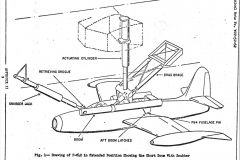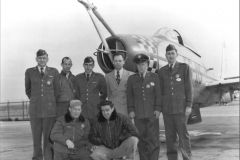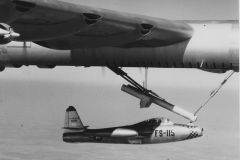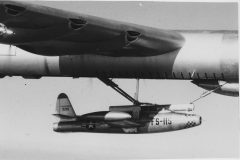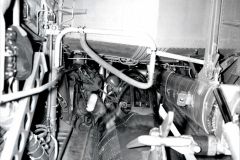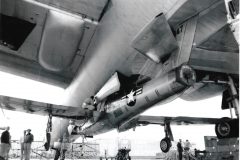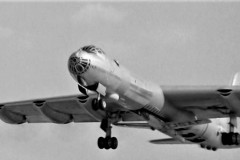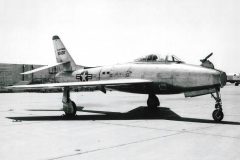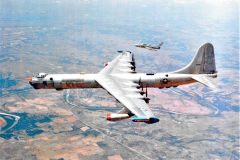FICON – Fighter Conveyer Experiment
During the Cold War we were trying almost anything we could think of to gain an advantage. The Strategic Air Command had a requirement for a very small fighter to be carried aboard the large B-36 ten engine bomber. McDonnell Aircraft Company was awarded the contract to develop a tiny fighter and the launching and retrieving system for it. A B36 was not available, so the Air Force loaned the contractor a four engine B-29 to serve as the mother ship. The tiny XP-85 fighter was a radical design and had no landing gear; just a skid. The intention was that the fighter would be launched and retrieved from the bomber, requiring no conventional take off or landings. The project was a huge failure and the contract was cancelled. In my opinion, they were trying to simultaneously develop a radical design for a fighter and an unusual launch and retrieving system. The only parasite fighter knowledge we had was obsolete; the tiny Curtis Sky Hawk biplanes hooking up under the huge Navy balloon airships, the Akron and the Macon.
So, with the knowledge we did have, it was decided to take a proven design fighter and develop a launch and retrieving system. We took a standard F-84E aircraft and used a real RB-36 as the mother ship, to develop the launch and recovery system. Convair, the manufacturer of the B36 was selected as the prime contractor and their huge factory on Carswell AFB, Ft Worth Texas, would be the test sight. I was selected as the government furnished test pilot to fly the F-84 fighter. I continued to work in Dayton, but remained on call. Every so often I would fly to Ft Worth, conduct a few tests then return home. This would happen many times before we had a safe workable system to retrieve the F84 on a boom and then be retracted into the bomb bay. The reverse the procedure and launch the fighter. The flying was very challenging and required skill. At first the fighter was unstable after hookup on the receiver. After that problem was solved, we had a mishap while conducting the first retraction into the bomb bay with the engine shut down. One of the aft latches in the recovery system broke, which overloaded the other latch that also broke. The fighter then dropped from the mechanism held only by the latch in the front end of the fighter. A few seconds later, I hit the emergency release and dropped away from the bomber. Then the second problem became obvious. I had released myself from the bomber at near stall speed for the fighter with a dead engine and I am at 10,000 feet altitude. I shoved the nose down to get enough air flow through the engine for a restart. It seemed like forever but I got a good engine restart and made a safe landing at Ft. Worth. After review and design changes we made many complete cycles. Take off separately, join up and then engage the retrieving system and be retracted into the bomb bay, where I could get out of my fighter and climb into the crew compartment. We also would load the fighter into the bomber’s bomb bay on the ground. We could then take off and climb to altitude, where we would launch and then retrieve the fighter.
The Air Force modified several RB-36 bombers into the Parasite configuration, as well as, a group of modified RF84Fs. But shortly afterwards, the Strategic Air Command said they had no further requirement for such a capability. They now had the U-2, in-flight refueling and satellites. Wow, our taxpayer’s dollars at work!! Well, there was a Cold War going on and we were doing everything we could to gain an advantage.
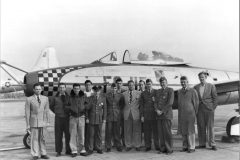 Bud with the F-84 Parasite Fighter Test Team - B. A. Hohman - Wright Field, Project Officer, Levine - Convair, B-36 Pilot, Coughlan - Wright Field, F-84 Crew Chief,T/Sgt. G. I. Davis - Convair, B-36 Pilot, Capt. J. S. McCollom - Wright Field, Project, Maj. C. E. Anderson - Wright Field, F-84 Pilot, Unknown - Convair, B-36 crew member, E. D. Mathis - Convair, Project Engineer, Roberts - Convair, Flight Test Engineer, Capt. R. D. Hodge - Wright Field, Project,Major Pinkerton - Wright Field, Photo Pilot Shedorski - Republic, Unknown
Bud with the F-84 Parasite Fighter Test Team - B. A. Hohman - Wright Field, Project Officer, Levine - Convair, B-36 Pilot, Coughlan - Wright Field, F-84 Crew Chief,T/Sgt. G. I. Davis - Convair, B-36 Pilot, Capt. J. S. McCollom - Wright Field, Project, Maj. C. E. Anderson - Wright Field, F-84 Pilot, Unknown - Convair, B-36 crew member, E. D. Mathis - Convair, Project Engineer, Roberts - Convair, Flight Test Engineer, Capt. R. D. Hodge - Wright Field, Project,Major Pinkerton - Wright Field, Photo Pilot Shedorski - Republic, Unknown

